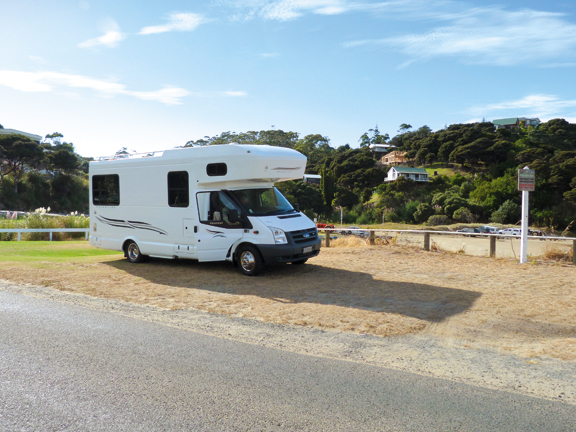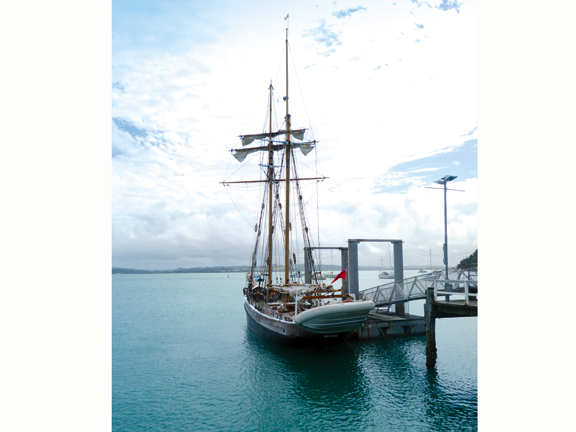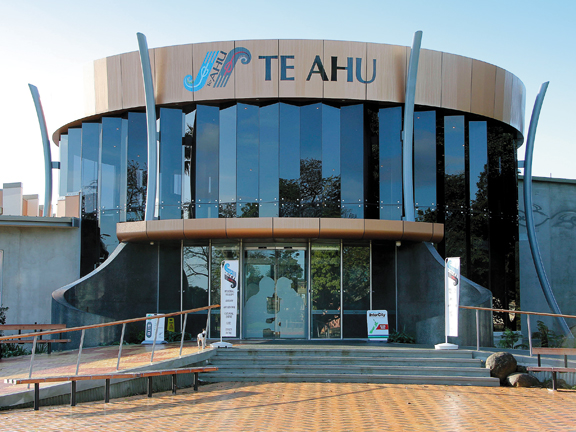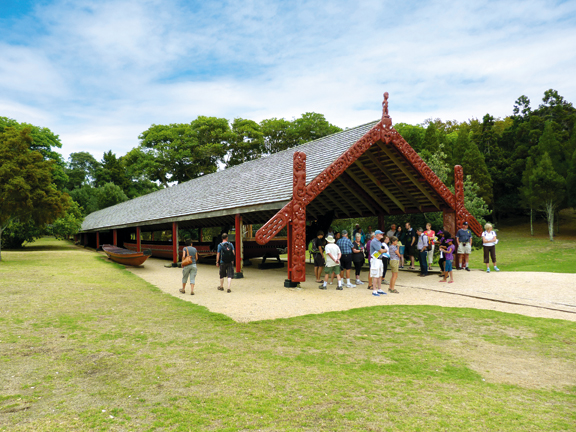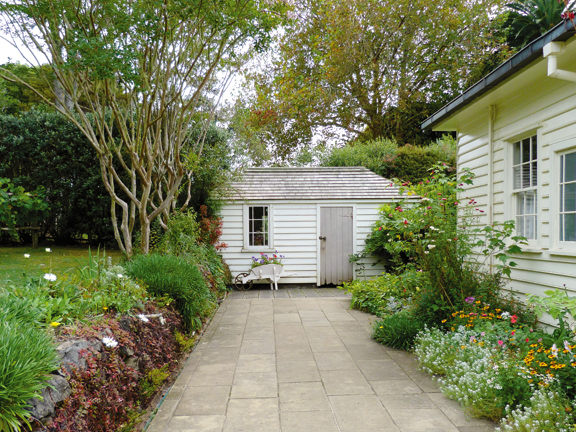My first home in New Zealand was a beached catamaran, stranded high on the sands of Shipwreck Bay, Ahipara, where I lived for two weeks in 1985. The vessel had been en route from Tasmania to Great Barrier Island when it was all but demasted off Cape Reinga, limping under jury rig to Ahipara, where it was dragged high and dry by local fishermen to await the fitting of a new sleeve in the mast.
With our two small daughters, we 'camped' in the hulls at magnificent 90 Mile Beach and shopped in Kaitaia, as I began to get a feel for my new home, New Zealand. To a recent immigrant, Kaitaia seemed dusty, depressed and soulless. It was an impression I retained during numerous subsequent visits, each one another failed attempt to reach Cape Reinga.
Contemporary Kaitaia comes as a magnificent surprise. There's a feeling of bustle and buoyancy and community pride, much of which is embedded in (and stems from) Te Ahu, the new community centre.
Te Ahu, combining the Far North Regional Museum with the Kaitaia Library, Far North District Council Services Office, iSite, memorial hall and cinema, opened to the public on Monday 13 February, 2012. Also in the complex is a video-conferencing suite, a computer training classroom, a café and the council's boardroom - all surrounding the impressive atrium which tells the district's history through an impressive architectural and artistic collaboration.
We spoke to Kaitaia library assistant John Haines, who told us more about the facility.
"The atrium was entirely conceived and designed locally, in a collaborative effort from Richard Murray of Image Nation, Paul Marshall of Paul Marshall Arts and Alan Simpkin and Doug Beard, both of Arcline Design," says John.
"The original idea had been to put the pou in a line but Paul came up with the concept of placing them in a circle, giving each represented group equal measure. Brilliant, don't you think?" Four pou are currently in place. "Peter Griffiths carved the European one, Paul has done Te Rarawa and it is my understanding Te Puia (a National Arts and Crafts consortium) are responsible for the Ngati Kuri pou. Duncan Kapa, who returned to the Far North after helping set up the Maori exhibit in Te Papa, was the lead carver for the Ngai Takoto pou.
"Three more pou representing Te Aupouri, Ngati Kahu and people of Dalmatian descent will stand alongside the current pou when they are completed," he explains.
John explained the rolled steel beams at the street entrance to the atrium represent the meeting of the two seas - the Tasman and the Pacific. "The floor of the atrium is the sea floor. More than 100 perspex kuaka (bar-tailed godwits) hang from the ceiling of the atrium in a flight formation, mimicking the migratory bird's annual journey to the northern hemisphere."
Steve La Hood headed a team from Wellington-based Story Inc in the interior design of the library and the Far North Regional Museum (now called the Heritage Museum). Story Inc computer-generated the Kupe panels in the library and the library forest scene based on the artwork of freelancer Andy Shaw.
Story Inc took on the mammoth task of designing not only the museum, but also the library, café, reception, atrium and all interior finishes and furnishings. The company claim the project has been one of their most rewarding and exciting projects to date.
John says the tree and suspension bridge are proving very popular with young visitors to the library. "Fell Engineering of Haruru Falls did the steel work for the tree. Human Dynamic of Wellington took moulds from a live kauri tree in order to create the authentic bark on our tree."
The brightly coloured panels in the library explain the story of Kupe, the first Maori explorer of New Zealand. After a strenuous voyage from Hawaiki, Kupe's wife Kuramaratini noticed the type of cloud only found above land and named this land Aotearoa.
"Kupe first landed in the Far North near Whangaroa and it was from here he eventually sailed back to Hawaiki and told how he had seen no smoke, fire or any sign of man. He gave the sailing directions to others to return to Aotearoa. Resting in old age in his place of origin, he entrusted his waka to his grandson, Nukutawhiti. It was re-adzed and renamed before its return to the Hokianga."
Kupe's map of New Zealand can be seen etched on steel story panels at Cape Reinga.
If Kaitaia was a surprise, so too was Karikari Peninsula, which I am ashamed to say I all but dismissed some issues ago, after a fleeting visit there. Shame on me. This time we drove further than the new beach subdivision and entered an area of more mature holiday homes.
There, the road winds down to the beach and Whatuwhiwhi Top Ten Holiday Park, on the edge of Doubtless Bay. We tucked ourselves into a back row shared only with a small tent, and walked along the beach in the late afternoon sunshine. Now doubtless, I was completely charmed by Karikari Peninsula and unreservedly apologise for my earlier recorded impressions.
The following day we visited the impressive cultural centre at the Waitangi Treaty Grounds, the 506-hectare site gifted to the nation by Lord and Lady Bledisloe in 1932 to permanently commemorate the signing of the Treaty of Waitangi in 1840.
Features include The Treaty House, Te Whare Runanga, and Ngatokimatawhaorua - one of the world's largest carved war canoes. Entry is free to New Zealanders and it is well worth taking time for a visit.
We lunched at Paihia before taking the return ferry crossing to Russell. Give me a ferry any day of the week, and I'll be a happy camper. There's something about a crossing that sets the mood for subsequent enjoyment. The co-pilot is the same. His only grumble was the five-minute crossing is too short.
'Hell hole of the Pacific' it might once have been, I love the character-filled mix of marine, history and magnificent scenery around Russell. I would have liked to linger longer and next time plan to once again stay at the holiday park, which is an easy stroll to the village.
Time was also too short to take the preferred coastal route south from Russell (see page 64 for Liz Light's story) and we re-boarded the ferry and headed for our next overnight stop at Tutukaka. I'd never been there, so this bustling harbour and marina was a pleasant surprise - as was the immaculately clean and family-oriented Tutukaka Holiday Park, set on a vast acreage with numerous powered, or non-powered, sites and holiday cabins.
The last day of any journey is a hard leg. This time, persistent misty rain set the mood as we headed home stopping only for a short walk around the attractive Whangarei Basin. Merging with the south-bound traffic on State Highway One, we bid a reluctant farewell to glorious Northland.
See part one of Peta's adventure here.
For the latest reviews, subscribe to our Motorhomes, Caravans & Destinations magazine here.

The road to Milford Sound
Explore the awe-inspiring journey to Milford Sound through Fiordland National Park – from scenic DOC campsites and iconic hikes to wildlife cruises and luxury stays

